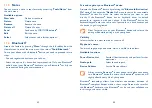
63
64
guidelines and establish permitted levels of RF energy for the general population. The guidelines are
based on standards that were developed by independent scientific organizations through periodic
and thorough evaluation of scientific studies. These guidelines include a substantial safety margin
designed to ensure the safety of all persons, regardless of age and health.
The exposure standard for cellphones employs a unit of measurement known as the Specific
Absorption Rate, or SAR. The SAR limit set by public authorities such as the Federal
Communications Commission of the uS Government (FCC), or by industry Canada, is 1.6 W/kg
averaged over 1 gram of body tissue. Tests for SAR are conducted using standard operating positions
with the cellphone transmitting at its highest certified power level in all tested frequency bands.
Although the SAR is determined at the highest certified power level, the actual SAR level of the
cellphone while operating can be well below the maximum value. This is because the cellphone is
designed to operate at multiple power levels so as to use only the power required to reach the
network. in general, the closer you are to a wireless base station antenna, the lower the power
output of the cellphone. Before a cellphone model is available for sale to the public, compliance with
national regulations and standards must be shown. The highest SAR value for this model cellphone
when tested is 0.84 W/Kg for use at the ear and 1.15 W/Kg for use close to the body. While there
may be differences between the SAR levels of various cellphones and at various positions, they
all meet the government requirement for RF exposure. For body-worn operation, the cellphone
meets FCC RF exposure guidelines provided that it is used with a non-metallic accessory with the
handset at least 10mm from the body. use of other accessories may not ensure compliance with
FCC RF exposure guidelines.
Additional information on SAR can be found on the Cellular Telecommunications & internet
Association (CTiA) Web site: http://www.ctia.org/
The World Health Organization (WHO) considers that present scientific information does not
indicate the need for any special precautions for use of cellphones. if individuals are concerned,
they might choose to limit their own or their children’s RF exposure by limiting the length of calls,
or using “hands-free” devices to keep cellphones away from the head and body. Additional WHO
information about electromagnetic fields and public health are available on the following website:
http://www.who.int/peh-emf.
Note: This equipment has been tested and found to comply with the limits for a Class B digital
device pursuant to part 15 of the FCC Rules. These limits are designed to provide reasonable
protection against harmful interference in a residential installation. This equipment generates,
uses and can radiate radio frequency energy and, if not installed and used in accordance with
the instructions, may cause harmful interference to radio communications. However, there is no
guarantee that interference to radio or television reception, which can be determined by turning
the equipment off and on, the user is encouraged to try to correct the interference by one or more
of the following measures:
•
Reorient or relocate the receiving antenna.
•
increase the separation between the equipment and receiver.
•
Connect the equipment into an outlet on a circuit different from that to which the receiver is
connected.
•
Consult the dealer or an experienced radio/ TV technician for help.
Changes or modifications not expressly approved by the party responsible for compliance could
void the user’s authority to operate the equipment.
For the receiver devices associated with the operation of a licensed radio service (e.g. FM
broadcast), they bear the following statement:
This device complies with Part 15 of the FCC Rules. Operation is subject to the condition that this
device does not cause harmful interference.
For other devices, they bear the following statement:
This device complies with Part 15 of the FCC Rules. Operation is subject to the following two
conditions:
(1) this device may not cause harmful interference
(2) this device must accept any interference received, including interference that may cause
undesired operation.
Your cellphone is equipped with a built-in antenna. For optimal operation, you should avoid touching
it or damaging it.
As mobile devices offer a range of functions, they can be used in positions other than against your
ear. in such circumstances the device will be compliant with the guidelines when used with headset
or uSB data cable. if you are using another accessory ensure that whatever product is used is free
of any metal and that it positions the cellphone at least 10mm away from the body.
IC Notice
This device complies with industry Canada license-exempt RSS standard(s). Operation is subject to
the following two conditions:
(1) this device may not cause interference, and
(2) this device must accept any interference, including interference that may cause undesired
operation of the device.
This Class B digital apparatus complies with Canadian iCES-003.
IC Radiation Exposure statement
This EuT is compliance with SAR for general population/uncontrolled exposure limits in iC RSS-102
and had been tested in accordance with the measurement methods and procedures specified in
iEEE 1528 and iEC 62209. This equipment should be installed and operated with minimum distance
10mm between the radiator and your body. This device and its antenna(s) must not be co-located
or operating in conjunction with any other antenna or transmitter.
lICENsEs:
Obigo®
is a registered trademark of Obigo AB.
microSD Logo is a trademark.
The Bluetooth word mark and logos are owned by the Bluetooth SIG, Inc.
and any use of such marks by TCL Communication Ltd. and its affiliates is
under license. Other trademarks and trade names are those of their respective
owners.
A392CC Bluetooth
®
QD ID B018931
•
Commercial mobile alert system (Cmas)
Your cellphone is CMAS capable and allows you to receive automatic alerts in times of crisis (e.g.
earthquake, hurricanes, etc.)



































